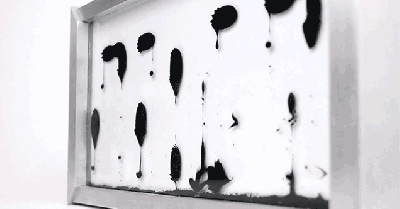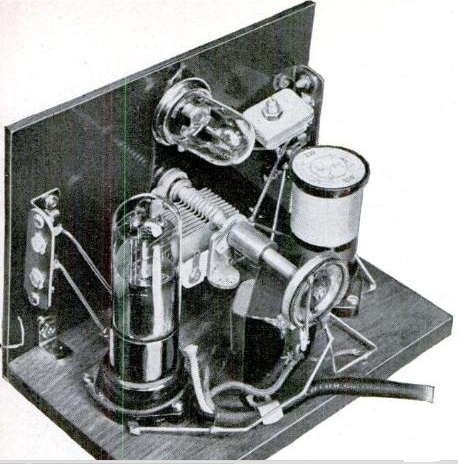What if there was a job where you built, serviced, and prepared science demonstrations? This means showing off everything from principles of physics, to electronic theory, to chemistry and biology. Would you grab onto that job with both hands and never let go? That was my reaction when I met [Dan Rosenberg] who is a Science Lecture Demonstrator at Harvard University. He gave me a tour of the Science Center, as well as a behind the scenes look at some of the apparatus he works with and has built.
Electronics and Physics Demo Gear

Here is a great example of what a physical demo for electronic principles is all about. When it comes time to explain inductors, [Dan] rolls this baby out for the professors and makes sure it’s ready to go in time for class. The giant pipe is wrapped with wire and connects to the schematic board on the front of the rack.


Of course it’s not just electronics that are covered in Harvard’s Science Center. Here is a microwave demonstration that uses this large black horn to generate the waves. The small incandescent light bulb is held in some plastic tubing on the end of a stick. Insert it into the path of the radio waves and it lights up. We wonder if your hand will feel hot if you don’t keep it out of the line of fire?
 Speaking of waves, stored right next to the inductor demonstration is a wave table that projects the patterns onto a screen. This is a really clever setup that predates the proliferation of document cameras in classrooms.
Speaking of waves, stored right next to the inductor demonstration is a wave table that projects the patterns onto a screen. This is a really clever setup that predates the proliferation of document cameras in classrooms.
You can make out a plate of glass laying flat. Just to the right and above is an audio speaker mount to face down at the plate of glass. To use the apparatus you pool water on top of the glass, and connect the speaker to a signal generator. Light shines up from below the glass, and reflects the wave patterns in the water on mirror which is mounted at a 45-degree angle to project the image onto the back of the white screen. I remember seeing these wave demonstrations on a reel-to-reel film in High School physics class. I think the apparatus easily doubles the cool-factor in this demo compared to a pre-recorded video.




For standing waves and wavelengths there is a long, clear oil-filled tube. A speaker at one end produces the waves which, when tuned to the correct wavelength produce a very visible standing wave. There are fluorescent tubes built-in to make the oil easily visible.
Dan posed next to the really big meter for scale. Again you can easily get a headless meter and project its output on a screen but you have to admit that this just feels more awesome. I think the same about demonstrating fire tornadoes and locking a freshman in a Faraday cage as the electricity storm (demo) rages around them.



This was really just the tip of the iceberg. The storage rooms are lined with cabinets full of demos, and every bit of floorspace is occupied by larger builds or collections like this pile of circuit illustration boards.
Because this was an impromptu tour I was only able to take pictures of the areas for which [Dan] is responsible. But we did get to walk through the chemistry and biology staging areas. In addition to these physical exhibits, the Demonstration Services are responsible for preparing chemicals for those demos and cleaning up afterward. There was even a 7-foot tall double-helix of a bit of human DNA that was about 2-feet in diameter. [Dan] assembled this from a kit with thousands of parts. He used the Tom Sawyer method of doing the tedious work in the lunch area — attracting students like flies who were eager to help.
Building these Demos


![[Dan] saves hard drive magnets](https://hackadaycom.files.wordpress.com/2015/08/dsc_0198.jpg?w=150&h=100)


If you want to build great stuff you need a shop and tools. [Dan] and a couple of his colleagues have a small bit of office space, but hop through one door and enter this sizable workshop. There are a ton of awesome machine tools; somehow I only snapped a picture of one-half of the shop, there is another area behind me with the rest of the gear.
As with any hacker, [Dan] likes to keep a well-populated junk bin. Shelves around this area are decorated with art made from the leavings. I really enjoyed the sculptures made of old motor commutators. It’s also hard to miss the stacks of hard drive magnets adorning many of the metal surfaces. There are hundreds of them and [Dan’s] sure he will find a really cool use for them some day.
First Programmable Computer in the US






A big bonus on this trip is the huge computer installed in the building’s lobby. This is the Harvard Mark I, the first programmable computer built in the United States. The machine takes a program on the input tape, along with the positions of a huge settings register, and automatically calculates an output. It was used during the Manhattan Project to calculate implosion models used when developing Trinity, the first atomic bomb.
This Chain is a Lie and Demonstration Services Videos

It’s always fun to throw a bit of a riddle into the tour. In the same part of the lobby as the Mark I (seen here from behind) there is a sculpture of a molecule, along with its makeup labeled on the stairway behind it. [Dan] tells me “the chain is a lie” but my chemistry chops are lacking so I couldn’t work it out myself. Can you spot the problem? If so, leave your explanation in the comments below.
If you find these Science Lecture Demonstrations as fascinating as I do, you’ll want to grind through their YouTube channel. I picked out two of my favorites below. The first features [Dan] showing the paramagnatism of Oxygen. The second is a blast from my childhood; a fission demonstration using mousetraps and ping pong balls that I first remember seeing at a very young age on the Mr. Wizard’s World television program.
Now if that isn’t even enough for you, all of the demos are cataloged on the Demonstration Services webpage.
Filed under:
Featured,
misc hacks 






 Speaking of waves, stored right next to the inductor demonstration is a wave table that projects the patterns onto a screen. This is a really clever setup that predates the proliferation of document cameras in classrooms.
Speaking of waves, stored right next to the inductor demonstration is a wave table that projects the patterns onto a screen. This is a really clever setup that predates the proliferation of document cameras in classrooms.








![[Dan] saves hard drive magnets](https://hackadaycom.files.wordpress.com/2015/08/dsc_0198.jpg?w=150&h=100)













 There’s little to no information on the details of how the clock works other than the use of ferrofluid. But it’s not hard to guess that it uses dozens of electromagnets
There’s little to no information on the details of how the clock works other than the use of ferrofluid. But it’s not hard to guess that it uses dozens of electromagnets 







 Film is projected at a rate of 24 frames per second, which is sufficient to create the POV illusion. A projector’s shutter inserts itself between the lamp and the lens, blocking the light to prevent projection of the film’s physical movement. But these short periods of darkness, or flicker, present a problem. Originally, shutters were made in the shape of a semi-circle, so they block the light half of the time. Someone figured out that increasing the flicker rate to 60-70 times per second would have the effect of constant brightness. And so the modern shutter has three blades: one blocks projection of the film’s movement, and the other two simply increase flicker.
Film is projected at a rate of 24 frames per second, which is sufficient to create the POV illusion. A projector’s shutter inserts itself between the lamp and the lens, blocking the light to prevent projection of the film’s physical movement. But these short periods of darkness, or flicker, present a problem. Originally, shutters were made in the shape of a semi-circle, so they block the light half of the time. Someone figured out that increasing the flicker rate to 60-70 times per second would have the effect of constant brightness. And so the modern shutter has three blades: one blocks projection of the film’s movement, and the other two simply increase flicker.